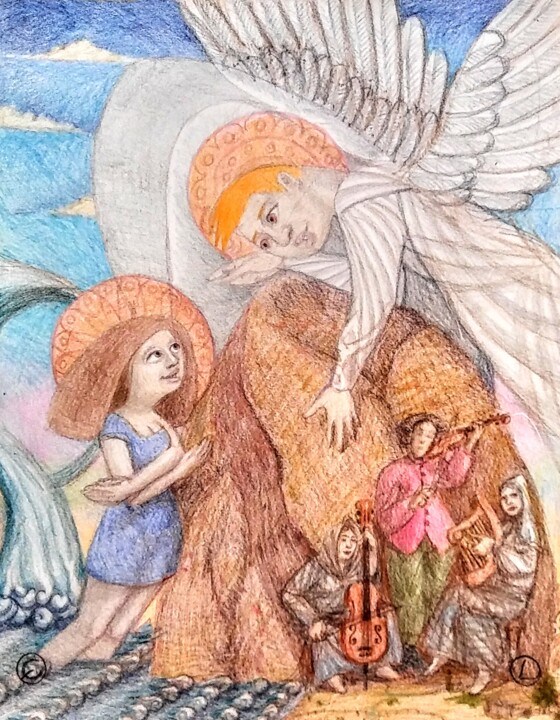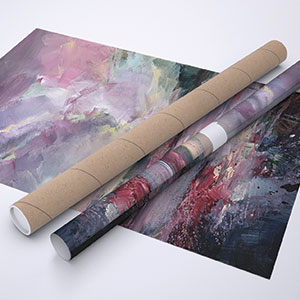


Let us know if you would like to see more photos of this artwork!
- Back of the work / Side of the work
- Details / Signature / Artwork's surface or texture
- Artwork in situation, Other...
Annunciation with String Accompaniment (2022) Drawing by Edwin Loftus
More info
- Packaging (Envelope) All artworks are shipped with a premium carrier, carefully protected and insured.
- Tracking Order tracking until the parcel is delivered to the buyer. A tracking number will be provided so that you can follow the parcel in real-time.
- Delay Worldwide delivery in 3 to 7 days (Estimate)
More info
- Trackable Online Certificate of Authenticity Authenticity Certificates can be verified online at any moment by scanning the artwork code.
- Artist Value Certification Experts study the work and career of an artist then establish an independent and reliable average price value. The average price value situates the artist on a price range for a given period. The experts may also be asked to establish a more precise estimate for a particular work.
More info
100% secure payment with SSL certificate + 3D Secure.
More info
"Fine-Arts" prints on paper
It is a process of printing on art paper using very high-quality pigment inks and printed in very high definition. Its level of conservation is exceptional (more than 100 years), its quality, depth, and richness of nuances exceeds the classic photo print on Argentic paper.

Glossy finish
Apart from its exceptional thickness, the fiber paper is composed of an alpha-cellulose base without acid and it is covered with barium sulphate, and a microporous layer absorption enhancing pigments during printing. A pure white color, non-yellowing to light, this paper is especially designed for resistance and aging. It is used by major museums worldwide as it offers excellent resolution, rendering deep and dense colors.
Art Print "Fine Art" - Glossy finish on a fiber base paper 325 g.

Our high end prints and reproductions
ArtMajeur only uses natural papers with neutral pH, resistant, and of high quality, selected from renowned papermakers!
Constant attention is paid by our master printer, whether in terms of color control or respect for the graphic chain. Our high level of quality requirement is a major asset of ArtMajeur framed art prints.
For Artists! You help artists to live from their work. They receive royalties everytime you buy their prints.
About our fine printsPurchase a license to use this image for your website, communications or to sell merchandise.
Usage: Web Licence
| 1166 px | ||

|
1500 px |
| Dimensions of the file (px) | 1166x1500 |
| Use worldwide | Yes |
| Use on multi-support | Yes |
| Use on any type of media | Yes |
| Right of reselling | No |
| Max number of prints | 0 (Zero) |
| Products intended for sale | No |
Download immediately upon purchase
This image is available for download with a licence: you can download them at anytime.
Restrictions
All images on ArtMajeur are original works of art created by artists, all rights are strictly reserved. The acquisition of a license gives the right to use or exploit the image under the terms of the license. It is possible to make minor modifications such as reframing, or refocusing the image so that it fits perfectly to a project, however, it is forbidden to make any modification that would be likely to harm the original work In its integrity (modification of shapes, distortions, cutting, change of colors, addition of elements etc ...), unless a written authorization is obtained beforehand from the artist.
Custom licences
If your usage is not covered by our standard licences, please contact us for a custom licence.
Art image bank-
Original Artwork (One Of A Kind)
Drawing,
Pastel
on Paper
- Dimensions Height 14in, Width 11in
- Artwork's condition The artwork is in perfect condition
- Framing This artwork is not framed
- Categories Drawings under $5,000 Symbolism Spirituality
However, the "Old" (pre-Christian) and "New" (post-Jesus) testaments have many omissions. In the Old Testament, the whole tale of Lilith, the fallen first mate of Adam is missing and with it the potentially important element that Adam and Eve might not have been the first man and woman. In the New Testament the "Apocrypha" and various essential tales are omitted as 'unreliably sourced', and yet The Revelation to John remains. "John" is apparently not the apostle, John but a figure who may have lived generations after Jesus and recorded a dream-vision about the end of the world.
I find myself of the camp that considers the Bible "inspirational" rather than literal. It is the wisdom of a culture recorded at a time when moral and philosophical teaching took place in this fashion in many cultures. Judaism, apparently an off shoot of Canaanite culture with Egyptian, Greek and Persian influences, became the foundation of Christianity and Christianity became an important and eventually dominant religion in the Roman Empire prior to its decline. This led to it becoming the dominant religion in Europe and a small part of Africa. Europe, long a culturally and technologically trailing region, gave rise to a new importance in science and technology that propelled it to prominence and often dominance in most of the world, including the two Americas, invaded by Christians during the religion's first global expansion. At this point it is the largest set of mostly common beliefs, with what are sometimes called the Vedic-based belief systems, Islam and atheism dominating the remaining majority of the world's population.
A peculiar story is the impregnation of Mary and the birth of Jesus. It is important in Christian belief that Jesus is "The Son of God" an avatar of God, the Creator and Controller of our destinies. My image only somewhat parallels the story of "The Anunciation" in which an angel appeared to Mary in her home to tell her that she had been selected as the woman who would give birth to God's son. A secondary annunciation was required for Joseph, Mary's betrothed because he had not lain with her, and custom favored those women who were virgins at the time of marriage. This was considered important in establishing the fatherhood of the first child born to a marriage and affected inheritance or, in the case, the claim of divinity.
In this image, I have presented Mary standing in water, symbolic of the historically questionable nature of this set of stories. The angel appearing before her fits the original story, though I have put Mary in modern dress to suggest that this tale still has relevance today.
Mary stands in water, not firm ground, a stylized wave rises behind her suggesting the questionable nature of the story, but the stones at the center of the image refer to the undeniability of the importance of it. This is reiterated in the presence of the string trio, expressive of the significant cultural importance of the story of "Mary, mother of God," a very peculiar concept unto itself.
Some smart person once said, "If God did not exist, man would have had to invent Him." I've seen this attributed to various people, but whomever said it was right, as far as I can discern. Without the presence of a superhuman source of commonly accepted moral wisdom, disputes between humans would amount to one person's opinion versus another's and the resolution of disagreements would almost never favor the weaker of the two disputants. The presence of an authority greater than our own perceptions has been the glue that bonds societies and the lubricant that allows them to adapt. It is a common ground on which they can stand, and this gives meaning to the stones at the center of the image and the paragraphs about the rise and importance of Christianity in the world today ... a uniting factor that we lose at our peril, (and the same is true for other foundational religious beliefs, each in their regions of dominance). Mary, in modern dress is, as stated, a reminder that these things are not just antiquities, but important elements in the world we know as well.
And this brings up the choice of a Medieval style. Between about 1200 AD and 1600 AD (and continuing today), Christianity went through a series of conceptual revolutions we know by names like, "The Renaissance", "The Enlightenment", and "The Reformation." (Asia has been going through a similar process and we may be seeing signs of this in Islam, as well). We are, today, still involved in the Reformation. The process it describes is not finished and still very much ongoing, as is the Enlightenment. These great "movements" in civilization do not, (as you may have been taught), have beginning and ending dates. They rise gradually out of precursors and ebb away as other movements replace them in prominence, for those not still struggling through them.
And ... OH MY GOODNESS! Do you realize ... this is actually just marks made with pigment on a felt made of plant fibers? Having it appear as though it is a window on another world "forces" the viewer to confront their assumptions about the nature of perception and reality and helps them come to grips with the here and the now, while ... doing all of these other things!
I just threw that in as a slap in the face to the deconstructivism of Modernist and Post-Modernist forms of art and a "bold challenge" to the narrow-mindedness of their linear view of artistic exploration and expression in which too many somehow think that it's perfectly acceptable to suppress those that pursue other forms of expression just because they are too ignorant and under cultivated to understand them ...
Related themes
Edwin Loftus is an American painter and draftsman born in 1951. His interest in art began at the age of 4 when he decided to draw something real rather than working from his imagination.
As a child he excelled at drawing and as a teenager he began to experiment with oil painting. In college, he took courses in art and art history and realized that true art had nothing to do with the quality of the drawing or painting, but that it had to have the ambition to push the boundaries and expand the visual experience.
He also studied philosophy, psychology and history and quickly realized that it was just another art establishment trying to defend its elitist industry and reward system. Their skills were almost non-existent, they knew nothing about psychology, perception or stimulus response, and they were extensions of the belief system that made communism, fascism and other forms of totalitarianism such destructive forces in the world. They literally believe that art shouldn't be available to ordinary human beings, but only to an elite "sophisticated" enough to understand it.
Edwin Loftus realized that the emperors of art had no clothes, but they were still the emperors. Gifted in art, he worked hard to acquire this skill. So he found other ways to make a living and sold a few artworks from time to time. For sixty years, many people enjoyed his works and some collected them.
Today, Edwin Loftus is retired. Even if he sold all his paintings for the price he asked, "artist" would be the lowest paid job he ever had... but that's the way it is. It won't matter to him after he dies. He just hopes that some people will like what he does enough to enjoy it in the future.
-
Nationality:
UNITED STATES

- Date of birth : 1951
- Artistic domains: Works by artists with a certified artist value,
- Groups: Certified Artists Contemporary American Artists







